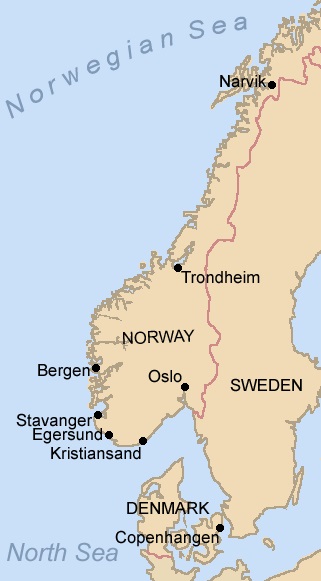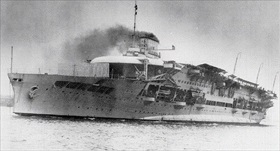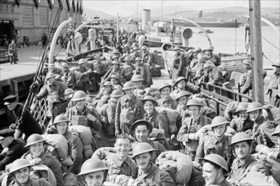GERMAN NAVY SINKS BRITISH CARRIER GLORIOUS
Berlin, Germany · June 8, 1940
In an operation remarkable for its precision and boldness, Germany launched Operation Weseruebung, the invasion of Norway on April 9, 1940, seized its capital, Oslo, and captured the important port of Narvik in Northern Norway. Narvik boasted an ice-free harbor during the long Scandinavian winters, and it was the rail terminus for anywhere from a tenth to a fifth of Germany’s iron ore imports in the late 1930s, chiefly from the Kiruna mining district in northernmost Sweden. (Iron ore was critical for wartime production of steel, but two Swedish iron ore ports, Luleå and Oxelösund, nearest the Kiruna mining district were ice-bound in winter.)
In late April 1940 retreating German soldiers, under pressure from British, French, Polish, and Norwegian forces, began a systematic and thorough destruction of Narvik’s harbor facilities to deny Swedish iron ore to their enemy. The next month, May, the British intended to reoccupy the port and complete its destruction as cover for evacuating British troops from the Norwegian theater of war—their services were needed closer to home—as well as to boost Allied morale in wake of the near disaster suffered by the British Expeditionary Force at Dunkirk on the northwestern coast of France and the impending collapse of their French ally, the events all occasioned by German aggression against France and the Low Countries begun on May 10, 1940.
The early-June evacuation of Narvik, hatched in deception as trust between Great Britain and her Norwegian ally sank to new lows, had shattering consequences for the Royal Navy. On this date, June 8, 1940, in the Norwegian Sea, German sister battlecruisers Scharnhorst and Gneisenau, built for speed, intercepted the British aircraft carrier HMS Glorious, along with escort destroyers Acasta and Ardent, and succeeded in sinking all three vessels with the loss of over 1,500 British seamen. Survivors numbered 40, including one each from Acasta and Ardent. The German battlecruisers, having been damaged in the engagement, broke off the seaborne operation, which allowed 20,000 troops in a later convoy to leave Norway and reach the safety of England. Remarkably, the Royal Navy did not learn of the calamity to their three warships until it was announced on German radio. Two days after the triple sinking, on June 10, 1940, the last Norwegian forces in Norway surrendered, abandoned by their Allies. It would be one month shy of five years before Norwegians extracted themselves from their oppressor’s tyranny.
Norway, June 1940: Allied Disasters on Land and Sea
 |
Above: Map of Norway and Denmark showing the German landing sites during the initial phase of Operation Weseruebung (Unternehmen Weserübung), April 1941. The Norwegian port of Narvik is near the top of the map. The Swedish iron ore mining district of Kiruna is directly east of Narvik (past the right edge of the map).
 |  |
Left: A World War I light battlecruiser, the HMS Glorious was converted to an aircraft carrier in the late 1920s. While evacuating British aircraft from the Narvik area in Norway in June 1940, the carrier (one of four in the Royal Navy) was sunk with the loss of over 1,200 lives by the German battlecruisers Scharnhorst and Gneisenau in the Norwegian Sea. Incredibly, the Glorious had no airborne patrols flying overhead, no aircraft on its deck ready for a quick response to the two attacking German warships, and no lookout in its crow’s nest in conditions of maximum visibility.
![]()
Right: Operation Alphabet was the evacuation of British, French, and Polish troops from Narvik. It was in recognition of the success of Germany’s Operation Weseruebung, which began on April 9, 1940, and signaled the end of the Allied campaign in Norway. The evacuation was completed by June 8, the day the HMS Glorious and her two destroyer escorts were sunk.
The German Invasions of Norway, Denmark, France, and the Low Countries, April–May 1940
![]()

 History buffs, there is good news! The Daily Chronicles of World War II is now available as an ebook for $4.99 on Amazon.com. Containing a year’s worth of dated entries from this website, the ebook brings the story of this tumultuous era to life in a compelling, authoritative, and succinct manner. Featuring inventive navigation aids, the ebook enables readers to instantly move forward or backward by month and date to different dated entries. Simple and elegant! Click
History buffs, there is good news! The Daily Chronicles of World War II is now available as an ebook for $4.99 on Amazon.com. Containing a year’s worth of dated entries from this website, the ebook brings the story of this tumultuous era to life in a compelling, authoritative, and succinct manner. Featuring inventive navigation aids, the ebook enables readers to instantly move forward or backward by month and date to different dated entries. Simple and elegant! Click 











